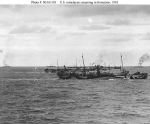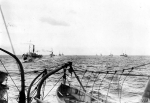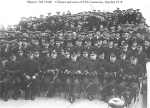NavSource Online:
Section Patrol Craft Photo Archive
Canonicus (ID 1696)
George - Quack - Boy - Dog |
Nan - Cast - Sail |
El Sud Class Freighter/Canandaigua Class Minelayer:
Specifications:
| Click on thumbnail for full size image |
Size | Image Description | Source | |
|---|---|---|---|---|
 |
350k | c. 1918 North Sea Photo © N. R. George from National Museum of the U.S. Navy |
Original photo: Naval Historical Center Replacement photo: Michael Mohl |
|
 |
294k | Original photo: Halftone reproduction of a photograph taken in British waters, 1918. Courtesy of Donald M. McPherson, 1976 U.S. Navy photo NH 85034 Replacement photo: Library of Congress photo LC-USZ62-38945 © by N. R. George from National Museum of the U.S. Navy |
Michael Mohl | |
 |
35k | c. 1918 Protected by smoke screen in the North Sea Library of Congress photo LC-USZ62-98344 from National Museum of the U.S. Navy |
||
 |
125k | U.S. Navy Mine Layers steaming in line abreast during the laying of the North Sea mine barrage, September 1918. Analysis of camouflage patterns indicates that these ships are (from front to rear): USS Roanoke (ID 1695); USS Housatonic (ID 1697); USS Shawmut (ID 1255); USS Canandaigua (ID 1694);
USS Canonicus (ID 1696); with USS Quinnebaug (ID 1687)and USS Saranac (ID 1702) in the left and right center distance. A four-stack British cruiser is in the left distance U.S. Navy photo 61101 |
Naval Historical Center | |
 |
71k | U.S. Navy minelayers proceeding to sea in two columns, in Area Number 2 of the North Sea, September 1918. Ships in the column at left are (from front to rear): Roanoke, Housatonic, Quinnebaug and Baltimore. Ships in column at right are (from front to rear): Canonicus (out of picture, to right), Canandaigua, Aroostook and Saranac. Photograph from the Army Signal Corps Collection in the U.S. National Archives. U. S. Army Signal Corps Photo 111-SC-43563 |
||
 |
111k | American minelayers underway on 20 September 1918. They include; on the right: USS Roanoke (ID-1695), USS Housatonic (ID-1697), USS Quinnebaug (ID-1687), USS Baltimore (CM-1). On the left: USS Canonicus (ID-1696), USS Canandaigua (ID-1694), USS Aroostook (CM-3), USS Saranac (ID-1702) Imperial War Museum photo No.© IWM(Q 20254) from American First World War Official Exchange Collection | Mike Green | |
 |
190k | Ship's officers and crew, photographed at Invergordon, Scotland, in October 1918. Her Commanding Officer, Captain Thomas L. Johnson, is seated in the center of the front row Naval History and Heritage Command photo NH 51900 |
Robert Hurst | |
 |
114k | Canonicus, in a U.S. East Coast port, while employed as a troop transport in 1919. Donation of Dr. Mark Kulikowski, 2005 Naval Historical Center photo NH 102942 |
||
 |
90k | Canonicus, in harbor in 1919, while employed as a troop transport. Donation of Dr. Mark Kulikowski, 2007 Naval Historical Center photo NH 105423 |
||
 |
190k | Arriving off Newport News, Virginia, with homeward bound troops from France, 10 July 1919 Panoramic photograph by Holladay, Newport News. The harbor tug Maren Lee is assisting Canonicus Donation of Dr. Mark Kulikowski, 2008 Naval History and Heritage Command photo NH 106362 |
||
| Commanding Officers | ||
| 01 | CDR Thomas L. Johnson, USN - Awarded the Navy Distinguished Service Medal | 2 March 1918 - 7 August 1919 |
|
|
Canonicus cleared Newport, R.I., 12 May 1918 with Mine Squadron 1, bound for Inverness, Scotland. Arriving 27 May, she operated out of Inverness and Invergordon, Scotland, planting the mines of the North Sea barrage. This precise, demanding work continued through the close of the war, after which she returned to Hampton Roads, VA., 3 January 1919.
On 7 February 1919 Canonicus was assigned to the Cruiser and Transport Force, and made three voyages between the east coast and France, returning 4,166 troops to the United States. Canonicus was decommissioned 7 August 1919, and returned to the Shipping Board for further transfer to her former owner.
| Back To The Main Photo Index | Back to the Identification Numbered Vessel (ID) Photo Index | Back To the Mine Warfare Ship Photo Index | Back To The Minelayer (CM) Photo Index |
| Comments, Suggestions, E-mail Webmaster |
|
This page created by Joseph M. Radigan and maintained by David Wright |